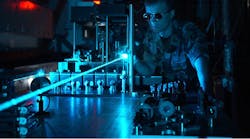Some of the effort to improve laser technology is also taking place within government organizations, such as the U.S. Naval Research Laboratory (NRL) and its investigations into the properties of materials for optical devices. A research team headed by the NRL has explored the optical loss characteristics and transmission efficiency of various materials, including hexagonal boron nitride (hBN) devices for extremely small lasers and nanoscale optics.
“The applications for this research are considerably broad,” said Dr. Alexander J. Giles, research physicist at the NRL Electronics Science and Technology Division. “By confining light to very small dimensions, nanophotonic devices have direct applications for use in ultra-high-resolution microscopes, solar energy harvesting, optical computing, and targeted medical therapies.”
This image shows directly measured polaritons propagating through a flake of hBN materials. (Image courtesy of Naval Research Laboratory)
This hBN material has shown great promise as an optical substrate, especially for two-dimensional device configurations, including infrared (IR) nanophotonics devices. The material may support applications in applications such as chemical sensing, energy conversion, and subdiffractional optical imaging.
“We have demonstrated that the inherent efficiency limitations of nanophotonics can be overcome through the careful engineering of isotopes in polar semiconductors and dielectric materials,” Giles explained. “The research team has focused on creating isotopically pure samples of hBN, enabling the further discoveries in the performance capabilities of the substrate.”


